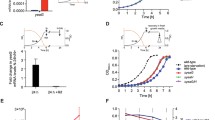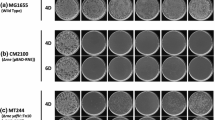Abstract
A strain of Schizosaccharomyces pombe carrying a disrupted Na+/H+ antiporter gene (sod2::sup3-5), in addition to the common auxotrophic mutations, ade6-216, ura4-D18 and leu1-32, is highly sensitive to media adjusted to pH 6.9. Reversion analysis of this strain yielded a group of revertants capable of growth at pH 6.9. Two of the revertants elongated and failed to form colonies at pH 3.5. Genetic characterization of one of the pH-sensitive elongated strains, J227, showed the presence of two independently segregating mutations. One, pub1 ( protein ubiquitin ligase 1), has recently been reported as an E3 protein ubiquitin ligase involved in cdc25 turnover. The second has been named elp3-1 (elongated at low pH). Genetic dissection of the original strain revealed that poor growth at high pH was due to the presence of the auxotrophic markers, suggesting a possible inhibitory effect of high pH on the function of permeases responsible for uptake of the necessary nutrients. Suppression of the high pH sensitivity required the presence of both the pub1-1 and elp3-1 mutations. While the pub1-1 mutation reduced the capacity of cells to tolerate relatively moderate concentrations of LiCl (3 mM) in liquid culture, it was capable of partially suppressing the extreme Li+ sensitivity caused by the sod2 disruption. Under these conditions, the growth of pub1-1 sod2::ura4 double mutant cells was improved over that of either pub1-1 or sod2::ura4 cells. The elp3-1 mutation had no effect on the Li+ tolerance in either wild-type or sod2::ura4 backgrounds. pub1-1 cells are elongated and incapable of colony formation at pH 3.5. In contrast, elp3-1 cells are elongated at pH 3.5 and pH␣5.5 (the normal pH of minimal medium) but can form colonies under both conditions. J227 cells are significantly longer than either single mutant at pH 3.5 and do not form colonies but are visually similar to elp3-1 cells at pH 5.5. Complementation cloning in the J227 background yielded a genomic clone of pub1, allowing us to define the intron-exon structure of the gene. Sequences with high homology to the predicted amino acid sequence of pub1 have been identified in Saccharomyces cerevisiae (RSP5/NPI1), human (hRPF1), mouse (mNedd4), and rat (rNedd4). Based on the nature of our mutant selection, the pH-sensitive phenotype of the strains selected, and the known involvement of RSP5/NPI1 in membrane permease turnover in S. cerevisiae, we hypothesize a role for pub1, either directly or indirectly, in regulating membrane transport processes. This is further supported by the broad range of effects that the pub1-1 mutation exerts on overall performance of cells at high and low external pH, and in the presence of toxic levels of Li+.
Similar content being viewed by others
Author information
Authors and Affiliations
Additional information
Received: 12 September 1996 / Accepted: 19 December 1996
Rights and permissions
About this article
Cite this article
Saleki, R., Jia, Z., Karagiannis, J. et al. Tolerance of low pH in Schizosaccharomyces pombe requires a functioning pub1 ubiquitin ligase. Mol Gen Genet 254, 520–528 (1997). https://doi.org/10.1007/s004380050447
Issue Date:
DOI: https://doi.org/10.1007/s004380050447




